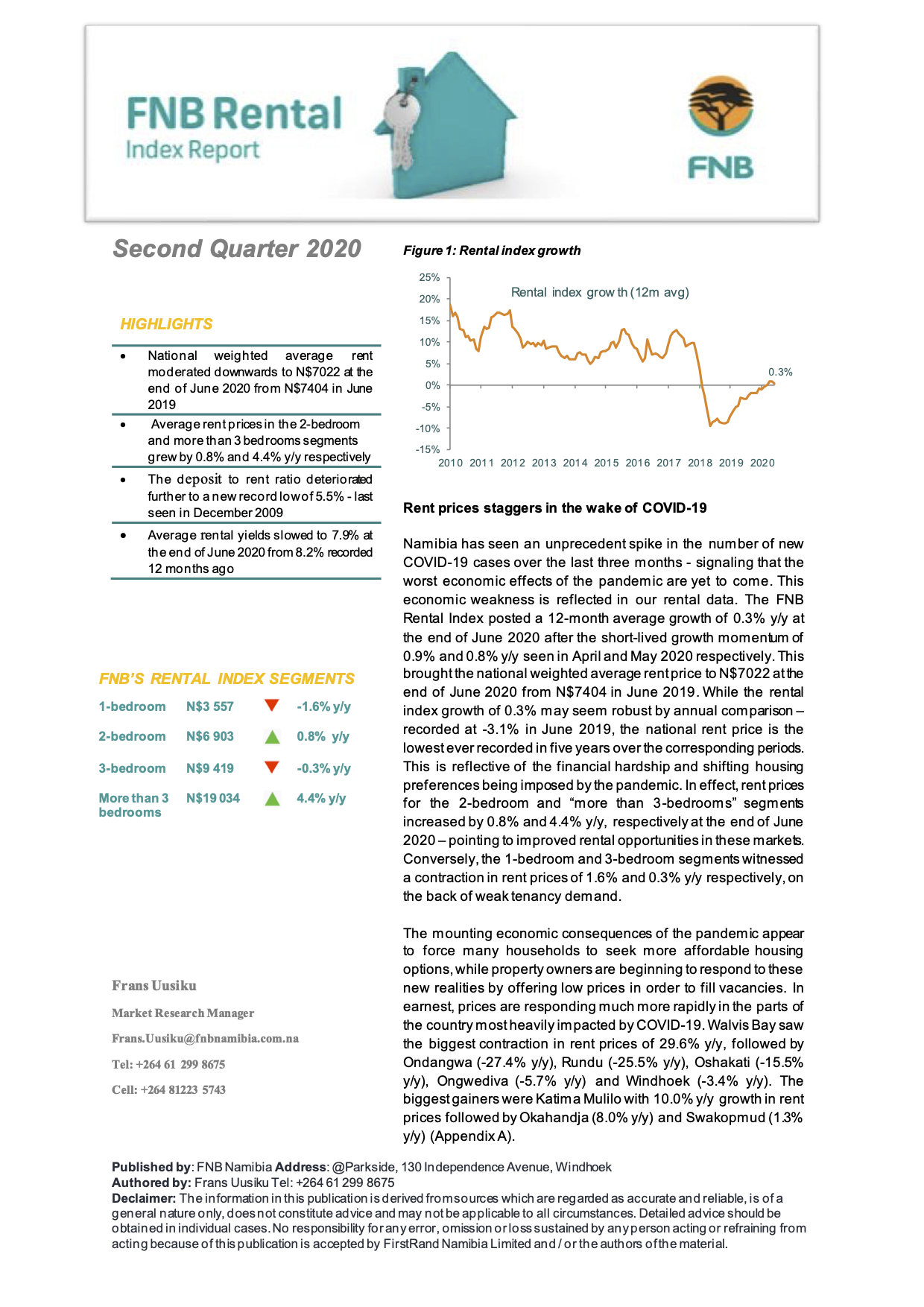
Frans Uusiku
Market Researcher Manager
FNB Housing Index Report
“Namibia has seen an unprecedent spike in the number of new COVID-19 cases over the last three months, signaling that the worst economic effects of the pandemic are yet to come”, says Frans Uusiku, Market Researcher Manager at FNB Namibia.
This economic weakness is reflected in FNB’s latest FNB Rental Index, which shows a 12-month average growth of 0.3% y/y at the end of June 2020, following the short-lived growth momentum of 0.9% and 0.8% y/y seen in April and May 2020 respectively. This brought the national weighted average rent price to N$7022 at the end of June 2020 from N$7404 in June 2019.
While the rental index growth of 0.3% may seem robust by annual comparison, recorded at -3.1% in June 2019, the national rent price is the lowest ver recorded in five years over the corresponding periods. This is reflective of the financial hardship and shifting housing preferences being imposed by the pandemic. In effect, rent prices for the 2-bedroom and “more than 3-bedrooms” segments increased by 0.8% and 4.4% y/y, respectively at the end of June 2020 – pointing to improved rental opportunities in these markets. Conversely, the one-bedroom and three-bedroom segments witnessed a contraction in rent prices of 1.6% and 0.3% y/y respectively, on the back of weak tenancy demand.
“The mounting economic consequences of the pandemic appear to force many households to seek more affordable housing options, while property owners are beginning to respond to these new realities by offering low prices in order to fill vacancies. In earnest, prices are responding much more rapidly in the parts of the country most heavily impacted by COVID-19”, adds Uusiku.
Walvis Bay saw the biggest contraction in rent prices of 29.6% y/y, followed by Ondangwa (-27.4% y/y), Rundu (-25.5% y/y), Oshakati (-15.5% y/y), Ongwediva (-5.7% y/y) and Windhoek (-3.4% y/y). The biggest gainers were Katima Mulilo with 10.0% y/y growth in rent prices followed by Okahandja (8.0% y/y) and Swakopmud (1.3% y/y).
The halt in normal rental activity by about 49% witnessed over the second quarter was foreseeable as COVID-19 related job losses had a direct material impact on the rental market. “While we do not see any significant rent reductions at the national level yet, rents have declined rapidly in the most heavily impacted towns such as Walvis Bay and the northern towns” he says.
Uusiku says looking ahead, “the impact of COVID-19 on rent prices should further be seen through two lenses. Firstly; how soon the COVID-19 cure is found and secondly; how quickly the economy is able to recover. In the event of a more drawn-out economic recovery, which is very likely, we may see a slowdown in new household formation and a shift towards a multifamily renting culture to save on housing costs. These dynamics could also mean that competition will remain tight for rental units at the middle and lower ends of the market, while luxury vacancies may become harder to fill. Furthermore, as the culture of remote work gains traction, we could also start to see a switch in residential preference – away from inner-city locations towards more affordable suburbs”.
CONTACT DETAILS:
Elzita Beukes
Communications Manager at FirstRand Namibia Limited
Tel: (+264 61) 299 2125











